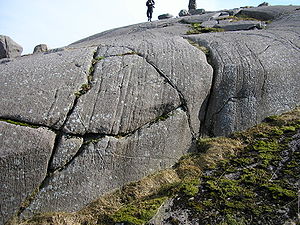.gif)
Fabric (geology)
Encyclopedia

Geology
Geology is the science comprising the study of solid Earth, the rocks of which it is composed, and the processes by which it evolves. Geology gives insight into the history of the Earth, as it provides the primary evidence for plate tectonics, the evolutionary history of life, and past climates...
, a rock's
Rock (geology)
In geology, rock or stone is a naturally occurring solid aggregate of minerals and/or mineraloids.The Earth's outer solid layer, the lithosphere, is made of rock. In general rocks are of three types, namely, igneous, sedimentary, and metamorphic...
fabric describes the spatial and geometric configuration of all the elements that make it up.
Types of fabric
- Primary fabric — a fabric created during the original formation of the rock, e.g. a preferred orientation of clast long axes in a conglomerateConglomerate (geology)A conglomerate is a rock consisting of individual clasts within a finer-grained matrix that have become cemented together. Conglomerates are sedimentary rocks consisting of rounded fragments and are thus differentiated from breccias, which consist of angular clasts...
, parallel to the flow direction, deposited by a fast waning current. - Shape fabric — a fabric that is defined by the preferred orientation of inequant elements within the rock, such as platy- or needle-like mineral grains. It may also be formed by the deformation of originally equant elements such as mineral grains.
- Crystallographic preferred orientationTexture (crystalline)In materials science, texture is the distribution of crystallographic orientations of a polycrystalline sample. A sample in which these orientations are fully random is said to have no texture. If the crystallographic orientations are not random, but have some preferred orientation, then the...
— in plastically deformed rocks, the constituent minerals commonly display a preferred orientation of their crystal axes as a result of dislocationDislocationIn materials science, a dislocation is a crystallographic defect, or irregularity, within a crystal structure. The presence of dislocations strongly influences many of the properties of materials...
processes. - S-fabric — a planar fabric such as cleavageCleavage (geology)This article is about rock cleavage, for cleavage in minerals see Cleavage Cleavage, in structural geology and petrology, describes a type of planar rock feature that develops as a result of deformation and metamorphism. The degree of deformation and metamorphism along with rock type determines the...
or foliationFoliation (geology)Foliation is any penetrative planar fabric present in rocks. Foliation is common to rocks affected by regional metamorphic compression typical of orogenic belts. Rocks exhibiting foliation include the standard sequence formed by the prograde metamorphism of mudrocks; slate, phyllite, schist and...
; when it forms the dominant fabric in a rock, it may be called an S-tectoniteTectoniteTectonites are metamorphic or tectonically deformed rocks whose fabric reflects the history of their deformation, or rocks with fabric that clearly displays coordinated geometric features that indicate continuous solid flow during formation. Planar foliation results from a parallel orientation of...
. - L-fabric — a linear fabric such as mineral stretching lineation where aggregates of recrystallised grains are stretched out into the long axis of the finite strain ellipsoidLame's stress ellipsoidLame's stress ellipsoid is an alternative to Mohr's circle for the graphical representation of the stress state at a point. The surface of the ellipsoid represents the locus of the endpoints of all stress vectors acting on all planes passing through a given point in the continuum body...
, where it forms the dominant fabric in a rock, it may be called an L-tectonite. - Penetrative fabric — a fabric that is present throughout the rock, generally down to the grain scaleParticle size (grain size)Particle size, also called grain size, refers to the diameter of individual grains of sediment, or the lithified particles in clastic rocks. The term may also be applied to other granular materials. This is different from the crystallite size, which is the size of a single crystal inside the...
, although this does also depend on the scale at which the observations take place.
See also
- Rock microstructureRock microstructureRock microstructure includes the texture of a rock and the small scale rock structures. The words "texture" and "microstructure" are interchangeable, with the latter preferred in modern geological literature...
- Texture (geology)Texture (geology)Texture in geology refers to the physical appearance or character of a rock, such as grain size, shape, arrangement, and pattern at both the megascopic or microscopic surface feature level. This includes the geometric aspects and relations amongst the component particles or crystals which is called...
- Orientation tensorOrientation TensorIn geology, especially in the study of glacial till, eigenvectors and eigenvalues are used as a method by which a mass of information of a clast fabric's constituents' orientation and dip can be summarized in a 3-D space by six numbers...

